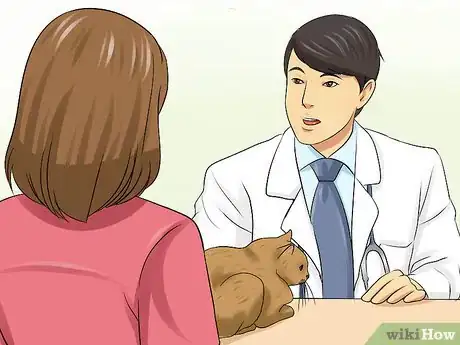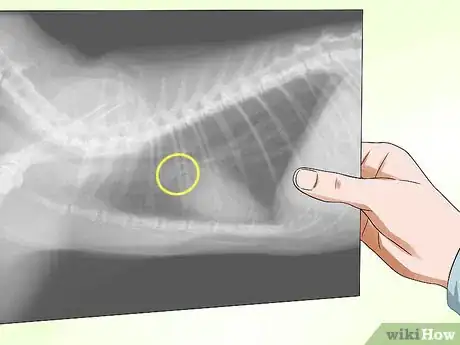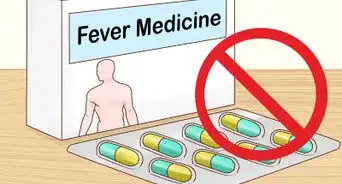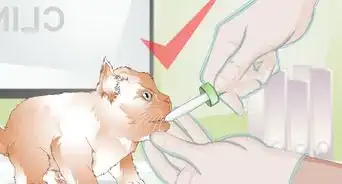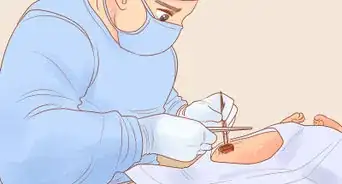This article was co-authored by Pippa Elliott, MRCVS. Dr. Elliott, BVMS, MRCVS is a veterinarian with over 30 years of experience in veterinary surgery and companion animal practice. She graduated from the University of Glasgow in 1987 with a degree in veterinary medicine and surgery. She has worked at the same animal clinic in her hometown for over 20 years.
This article has been viewed 30,686 times.
Feline lymphosarcoma, or lymphoma, is a type of cancer that affects the white blood cells, which are called lymphocytes.[1] These cells are part of the body's immune system and have the function of fighting infection. However, a cat with lymphosarcoma produces excessive numbers of lymphocytes and they flood the body. Where the white cells accumulate determines what type of lymphosarcoma your cat has. Lymphosarcoma will make your cat very ill, and so it's important to recognize the signs of the disease and take the cat to the vet to get treated as soon as possible.
Steps
Looking For the Signs of Feline Lymphosarcoma
-
1Pay attention to the signs of general illness. Many of the signs of lymphosarcoma are vague and are the symptoms of many other illnesses. This is because lymphosarcoma can affect a variety of organs, so the symptoms can vary quite a bit.[2] However, symptoms to look out for include diarrhea, vomiting, fatigue, and weight loss.
- A good example of how general the symptoms are is diarrhea, which can signal a variety of illnesses. The vagueness of symptoms is why it's important to pay attention to your cat's general healthy and to get your cat checked by a vet, who can perform a clinical examination and draw up a list of possible causes.
- Also, the symptoms will vary depending on what type of lymphoma the cat has. When the lymphocytes flood different areas and organs, the results differ greatly.
- Most affected cats fall into the 10-12 year old age bracket, but others occur outside this range. This means that if your cat is having these general symptoms of illness, and it is also old, the likelihood that the symptoms are caused by lymphosarcoma are greater.
-
2Check your cat's lymph nodes. Enlarged lymph nodes are a symptom of lymphosarcoma. The nodes become swollen and easy to feel. These exist in pairs (one gland on the left and one of the right of the body) in a mirror image of each other.[3] [4]
- The easiest to feel are the submandibular (in the angle of the jaw) prescapular (in front of the shoulder blades) axillary (in the armpit) inguinal (in the groin) and popliteal (behind the knee).
- These glands are usually not easy to find and unless you are a trained veterinary professional. They can vary in size from a small quail's eggs to golf ball sized.
Advertisement -
3Keep an eye on your cat's weight. Make sure that it stays relatively steady. Weight loss is one symptom of lymphosarcoma, although it can signal a variety of illnesses. This is because the cat loses its appetite as a result of feeling unwell, not because of the specific disease.
- Even if your cat has lost its appetite, it may have an increased thirst. Cancer can change levels of certain minerals in the blood stream, which can cause the cat to be thirsty.
-
4Look for vomiting or diarrhea. This can arise in any form of lymphosarcoma, but most commonly with lymphoma in the gut. This is due to the fact that the gut has a reduced ability to absorb the nutrition from food.
- The vomiting and diarrhea associated with lymphosarcoma is the same as vomiting and diarrhea associated with a wide variety of illnesses. Because of this, get your cat looked at by a veterinary professional if it has these symptoms. The cat could have a simple intestinal bug or may be very ill and your veterinarian is the best person to assess this.
-
5Keep track of your cat's activity level. Assess whether your cat is acting normally or whether it is acting strangely. Decreased activity, such as the cat being lethargic, lacking energy, and seeming unwell, can be a symptom of lymphosarcoma.
- This can also show itself through lack of grooming activity, so the cat's coat becomes dull looking and unkempt.
-
6Be concerned if your cat is having difficulty breathing. Lymphosarcoma can get into the lungs and make it very difficult for a cat to breathe.[5] The cat may take rapid shallow breaths. The cat may also change the way it sits or lays if it is having difficulty breathing.
- For example, it may not want to curl up but instead rest with its head and neck extended in order to make it easier to breathe.
Getting a Veterinary Diagnosis
-
1Take your cat to a veterinarian. If you suspect that your cat is ill and you are not sure what it causing it, get the cat looked at by a veterinary professional. Lymphosarcoma has similar symptoms to a wide variety of illnesses, so its best to let your veterinarian know about your cat's symptoms and let the vet sort out a diagnosis.[6]
- Your veterinarian will give the cat a general examination and assess its general health first. Then he or she will proceed with assessment of the illness.
-
2Confer with your veterinarian about options for testing. After a clinical examination, the vet will decide which are the most appropriate tests to run. If you are concerned about cost, feel free to discuss with the vet the costs of certain tests. A screening blood test is required in order to check on the cat's overall health and the impact the suspected lymphoma is having on organ function. The vet will also want to know if the cat is vaccinated against FeLV or not. The vaccination protects against certain forms of this cancer.
- The cat will also be screened for FeLV and FIV. While positive tests increase the chance of lymphoma, a negative test does not rule out lymphoma.[7]
- The key diagnostic tool is examining cells from the swollen lymph node under a microscope. This can either be done by the vet taking a biopsy, or in some cases when the external lymph nodes are swollen it is possible to reach a diagnosis based on a fine needle aspirate. This is when the vet harvests a sample through a hypodermic needle and sprays the cells onto a microscope slide. When a pathologists looks at those cells under the microscope they can identify the type as lymphocytes and confirm they are present in abnormal numbers.
- It is also important to work out if other organs are affected, so the vet will probably want to complete a scan of the internal organs included liver, spleen, and kidneys.
-
3Discuss the diagnosis with your veterinarian. Diagnosis can be difficult with certain forms of lymphosarcoma and you and your veterinarian should discuss this difficulty. The most common form of lymphoma affects the gut, with the bowel wall becoming flooded with lymphocytes. This can be more difficult to diagnose as the thickening is internal and signs of a problem tend to be nonspecific, such as vomiting or diarrhea, and can be caused by any number of problems. This is known as alimentary lymphoma.
- A rarer form of lymphoma affects a lymph gland inside the chest, which sits centrally between the right and left lungs. This is known as mediastinal lymphoma. Older cats can be prone to lymphoma affecting the kidneys and this is known as renal lymphoma.
- The alimentary, renal, or intestinal forms can be difficult to diagnose because the swelling is internal. The vet will perform an ultrasound exam and attempt an ultrasound guided biopsy or to harvest a fine needle aspirate using the ultrasound to guide the needle placement.
- The easiest to diagnose is when the lymphocytes accumulate in lymph nodes. This is because these are located external to the body cavities and are easy to feel when they are enlarged. This is known as multicentric lymphoma.
-
4Follow your veterinarian's suggestions for treatment. Treatment usually involves chemotherapy. However, surgical removal of a discrete intestinal mass may be possible. These treatment options can cost quite a bit, so you should discuss the cost before scheduling the surgery.
- Even with treatment, lymphosarcoma is not usually curable. Treatment can extend your cat's life for months, or even years, but does not usually eliminate the condition all together.
- Consider getting pet insurance while your cat is in good health. This will help to offset the cost of expensive medical treatments, such as this.
References
- ↑ http://www.ivghospitals.com/service/oncology/feline-lymphoma/
- ↑ http://vth.vetmed.wsu.edu/specialties/oncology/information-for-owners/cat-lymphoma
- ↑ http://www.lbah.com/word/canine/lymph-node-diseases/
- ↑ http://lib.dr.iastate.edu/cgi/viewcontent.cgi?article=3044&context=iowastate_veterinarian
- ↑ http://vth.vetmed.wsu.edu/specialties/oncology/information-for-owners/cat-lymphoma
- ↑ http://www.petmd.com/cat/conditions/cancer/c_ct_lymphoma
- ↑ http://www.ivghospitals.com/service/oncology/feline-lymphoma/
About This Article
If you've noticed potential signs of feline lymphosarcoma in your cat, like diarrhea, vomiting, fatigue, weight loss, difficulty breathing, lethargy, or swollen lymph nodes, take it to see a vet so they can help you figure out what's going on. Keep in mind that these symptoms can indicate other illnesses that aren't feline lymphosarcoma, so it's best to let a vet diagnose your cat. The vet will perform a physical exam and possibly do x-rays and tests, depending on your cat's symptoms. Unfortunately, lymphosarcoma isn't usually curable, but there are things the vet can do to prolong your cat's life, like chemotherapy. For advice from our Veterinary co-author, like how to check your cat’s lymph nodes for swelling, keep reading.






